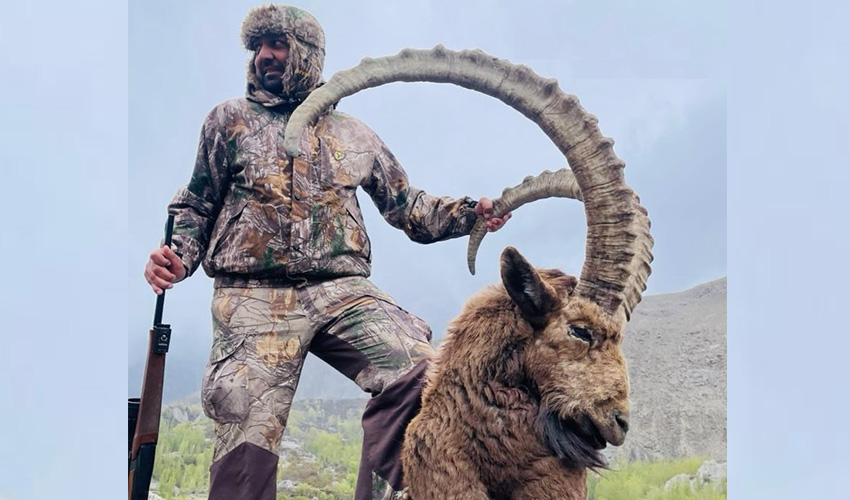GILGIT: Renowned Pakistani hunter Syed Murtaza Zaidi from Islamabad hunted an ibex on 25 April at Gulkin — a village near Passu located in Hunza Valley, after obtaining the license.
In February, Zaidi successfully hunted a large-sized ibex at the Khunjerav Villagers Organization (KVO) Conservancy in GojalHunza. Both trophies were above the 50-inch mark.
It is important to note that in 2021, Zaidi hunted AstoreMarkhor with 46 inch horn in Dashkin-Mushkin-Tarbuling (DMT) conservation area in Astore. Zaidi is the first Pakistani hunter to hunt AstoreMarkhor under the trophy hunting program.
Syed Murtaza Zaidi is known for his passion for wildlife and ethical hunting practices, and continues to contribute to the conservation efforts in Gilgit-Baltistan. He had previously hunted ibex and AstoreMarkhor in Astore and Gojal Conservancy.
It is relevant to mention that 80 percent of the money paid for hunting permits directly benefits the local community, with the remaining 20 percent allocated to the national Treasury.
Gilgit-Baltistan has witnessed a significant rise in the population of ibex and Markhor in recent years, a testament to the successful conservation efforts undertaken by local communities.Through sustainable hunting practices and conservation initiatives, the region has managed to maintain a delicate balance between wildlife preservation and economic sustainability.
The local community of Gilgit-Baltistan has played a pivotal role in fostering a conducive environment for the sustainable hunting of wildlife.
Last year, the Gilgit-Baltistan government has set a minimum bid of $5,500 for the sale of 20 Himalayan ibex permits for hunting the animals remaining in the first phase of the quota allocated for the current year. The permits will be awarded to foreign hunters only.
Gilgit-Baltistan Parks and Wildlife Department Conservator Khadim Abbas while talking to the media informed about these permits and the hunting of Markhor, ibex and blue sheep in Gilgit-Baltistan. Khadim Abbas said that 4 permits for Markhor, 100 for Ibex and 14 for Blue Sheep are given through regular tender for one year.
“In Gilgit-Baltistan at present the population of ibex is 12 to 15 thousand, the number of Markhor is 1800 to 2000 and the number of blue sheep is 1200 to 1300, Khadim added. He said that during the last bid, the highest bid for Markhor was 186 thousand dollars, the second one was 182 thousand dollars, the third permit was 177 thousand Dollars and the fourth permit was 171 thousand dollars.
It has 3 categories with separate rates for GB, National and Foreign hunters. He said that surveys are conducted twice a year regarding the population of these types of animals in Gilgit-Baltistan.
He said 80% of the revenue from these permits is spent by the local population while 20% is deposited in the Forest and Wildlife Fund. He said that the conditions during the Markhor permit include that the antlers of the animal to be hunted must be above 38 inches. He said that due to giving 80 per cent of the hunting share of permits to local people, the endangered population of these animals has increased significantly.


